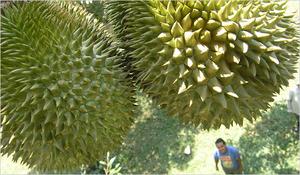New Nearly Scentless Durian; Left-Handed & Right-Handed Molecules; Masculine Florals; Jeanne D'Arc's Relics Smelled of Vanillin; Religious Perfume Marketing {The 5th Sense in the News}
The New York Times has an article about a new breed of durian, an equatorial and tropical fruit surrounded by folklore that is famous for its pungent smell and uber-creamy texture. The breeders of the new variety have apparently succeeded in toning down its distinctive aroma. Once you get used to the old-style durian, it's delicious.
Fans Sour on Sweeter Version of Asia's Smelliest Fruit .......
Chemists from the Université de Fribourg have developed an optical spectometer that allows them to determine in record time whether a molecule is a left-handed one or a right-handed one. This property of molecules is called chirality. "A molecule is chiral when it cannot be superimposed onto its mirror image." This spectometer can detect chirality at extremely low levels. It has very significant implications for the perfumery and pharmacological industries since, for example, a limonene molecule smells of lemon if it is right-handed and of orange if it is left-handed. A tragic example of this asymmetric property was revealed in the use of Thalidomide when it was given to pregnant women in the 1970s to combat nausea. One of the two forms of the molecule had no secondary effects, while the other one resulted in malformations in the babies.
The article is in Nature. I can't find the link there. Here's a link to Chemistry World.
Maïté Turonnet reviews some of the recent masculine releases and notices the renewed popularity of masculine florals.
Pour Les Hommes, C'est Le Bouquet
When professionals of the perfume industry Sylvaine Delacourte and Jean-Michel Duriez are called upon to help decipher the enigma of Jeanne D'Arc's remains with their noses,
"Delacourte and Duriez sniffed the relics and nine other samples of bone and hair from Charlier's lab without being told what the samples were. They were also not allowed to confer. Both smelled hints of 'burnt plaster' and 'vanilla' in the samples from the relics.
The plaster smell was consistent with the fact that Joan of Arc was burnt on a plaster stake, not a wooden one, to make the whole macabre spectacle last longer. But vanilla is inconsistent with cremation. "Vanillin is produced during decomposition of a body," says Charlier. "You would find it in a mummy, but not in someone who was burnt."
Joan of Arc's relics exposed as forgery; Joan of Arc 'From An Egyptian Mummy'
An attempt at capturing the scent of virtue and the attention of religious people.
Heaven Scent: 'Virtue' Perfume Reminds Wearer of God Says Niche Fragrance Company










